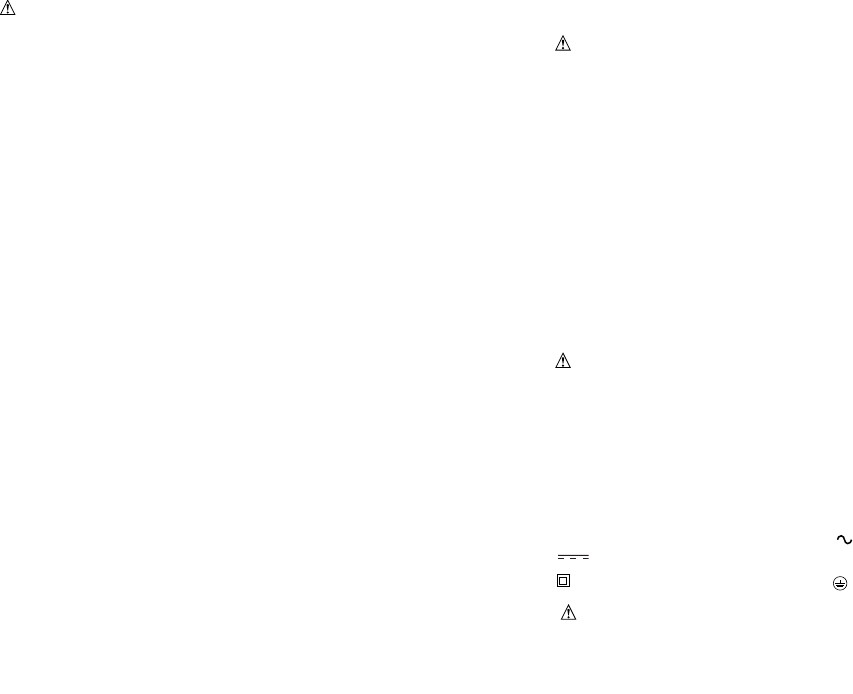
Kickback Safety Features
WARNING: The following features are included on your saw
to help reduce the hazard of kickback; however such features
will not totally eliminate this dangerous reaction. As a chain saw
user do not rely only on safety devices. You must follow all safety
precautions, instructions, and maintenance in this manual to help
avoid kickback and other forces which can result in serious injury.
• Reduced-Kickback Guide Bar, designed with a small radius tip
which reduces the size of the kickback danger zone on bar tip. A
reduced - kickback guide bar is one which has been demonstrated
to significantly reduce the number and seriousness of kickbacks
when tested in accordance with safety requirements for electric
chain saws.
• Low-Kickback Chain, designed with a contoured depth gauge and
guard link which deflect kickback force and allow wood to gradually
ride into the cutter. Alow-kickback chain is a chain which has met
kickback performance requirements of ANSI B175.1-1991.
• Do not operate chain saw while in a tree, on a ladder, on a
scaffold, or from any unstable surface.
• Hold tool by insulated gripping surfaces when performing an
operation where the cutting tool may contact hidden wiring.
Contact with a "live" wire will make exposed metal parts of the tool
"live" and shock the operator.
• Do not attempt operations beyond your capacity or
experience. Read thoroughly and understand completely all
instructions in this manual.
• Before you start chain saw, make sure saw chain is not
contacting any object.
• Do not operate a chain saw with one hand! Serious injury to
the operator, helpers, or bystanders may result from one
handedoperation.Achainsawis intendedfortwo-handeduse only.
• Keep the handles dry, clean, and free of oil or grease.
• Do not allow dirt, debris, or sawdust to build up on the motor
or outside air vents.
• Stop the chain saw before setting it down.
• Do not cut vines and/or small under brush.
5
• Use extreme caution when cutting small size brush and
saplings because slender material may catch the saw chain and
be whipped toward you or pull you off balance.
WARNING: Some dust created by power sanding, sawing,
grinding, drilling, and other construction activities contains chemicals
known to the State of California to cause cancer, birth defects or
other reproductive harm. Some examples of these chemicals are:
• lead from lead-based paints,
• crystalline silica from bricks and cement and other masonry
products, and
• arsenic and chromium from chemically-treated lumber.
Your risk from these exposures varies, depending on how often
you do this type of work. To reduce your exposure to these
chemicals: work in a well ventilated area, and work with approved
safety equipment, such as those dust masks that are specially
designed to filter out microscopic particles.
• Avoid prolonged contact with dust from power sanding,
sawing, grinding, drilling, and other construction activities.
Wear protective clothing and wash exposed areas with soap
and water. Allowing dust to get into your mouth, eyes, or lay on the
skin may promote absorption of harmful chemicals.
WARNING: Use of this tool can generate and/or disburse
dust, which may cause serious and permanent respiratory or
other injury. Always use NIOSH/OSHA approved respiratory
protection appropriate for the dust exposure. Direct particles away
from face and body.
SAVE THESE INSTRUCTIONS
SYMBOLS
The label on your tool may include the following symbols.
V................volts A ....................amperes
Hz..............hertz W ..................watts
min............minutes ..................alternating current
..........direct current
n
o ..................no load speed
..............
Class II Construction
....................earthing terminal
............safety alert symbol .../min ............revolutions per
minute


















